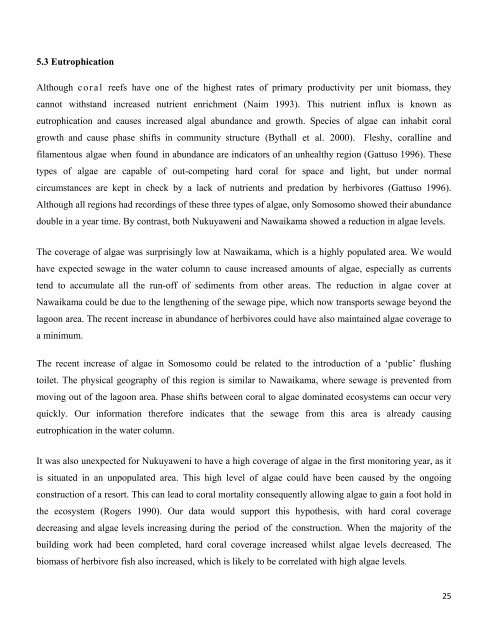Frontier Fiji Marine Environmental Research - Frontier-publications ...
Frontier Fiji Marine Environmental Research - Frontier-publications ...
Frontier Fiji Marine Environmental Research - Frontier-publications ...
Create successful ePaper yourself
Turn your PDF publications into a flip-book with our unique Google optimized e-Paper software.
5.3 Eutrophication<br />
Although coral reefs have one of the highest rates of primary productivity per unit biomass, they<br />
cannot withstand increased nutrient enrichment (Naim 1993). This nutrient influx is known as<br />
eutrophication and causes increased algal abundance and growth. Species of algae can inhabit coral<br />
growth and cause phase shifts in community structure (Bythall et al. 2000). Fleshy, coralline and<br />
filamentous algae when found in abundance are indicators of an unhealthy region (Gattuso 1996). These<br />
types of algae are capable of out-competing hard coral for space and light, but under normal<br />
circumstances are kept in check by a lack of nutrients and predation by herbivores (Gattuso 1996).<br />
Although all regions had recordings of these three types of algae, only Somosomo showed their abundance<br />
double in a year time. By contrast, both Nukuyaweni and Nawaikama showed a reduction in algae levels.<br />
The coverage of algae was surprisingly low at Nawaikama, which is a highly populated area. We would<br />
have expected sewage in the water column to cause increased amounts of algae, especially as currents<br />
tend to accumulate all the run-off of sediments from other areas. The reduction in algae cover at<br />
Nawaikama could be due to the lengthening of the sewage pipe, which now transports sewage beyond the<br />
lagoon area. The recent increase in abundance of herbivores could have also maintained algae coverage to<br />
a minimum.<br />
The recent increase of algae in Somosomo could be related to the introduction of a ‘public’ flushing<br />
toilet. The physical geography of this region is similar to Nawaikama, where sewage is prevented from<br />
moving out of the lagoon area. Phase shifts between coral to algae dominated ecosystems can occur very<br />
quickly. Our information therefore indicates that the sewage from this area is already causing<br />
eutrophication in the water column.<br />
It was also unexpected for Nukuyaweni to have a high coverage of algae in the first monitoring year, as it<br />
is situated in an unpopulated area. This high level of algae could have been caused by the ongoing<br />
construction of a resort. This can lead to coral mortality consequently allowing algae to gain a foot hold in<br />
the ecosystem (Rogers 1990). Our data would support this hypothesis, with hard coral coverage<br />
decreasing and algae levels increasing during the period of the construction. When the majority of the<br />
building work had been completed, hard coral coverage increased whilst algae levels decreased. The<br />
biomass of herbivore fish also increased, which is likely to be correlated with high algae levels.<br />
25
















